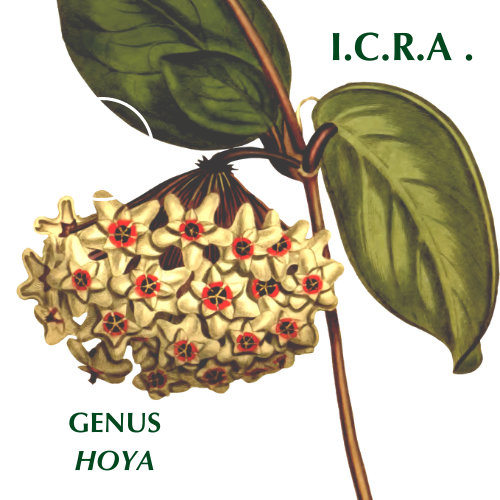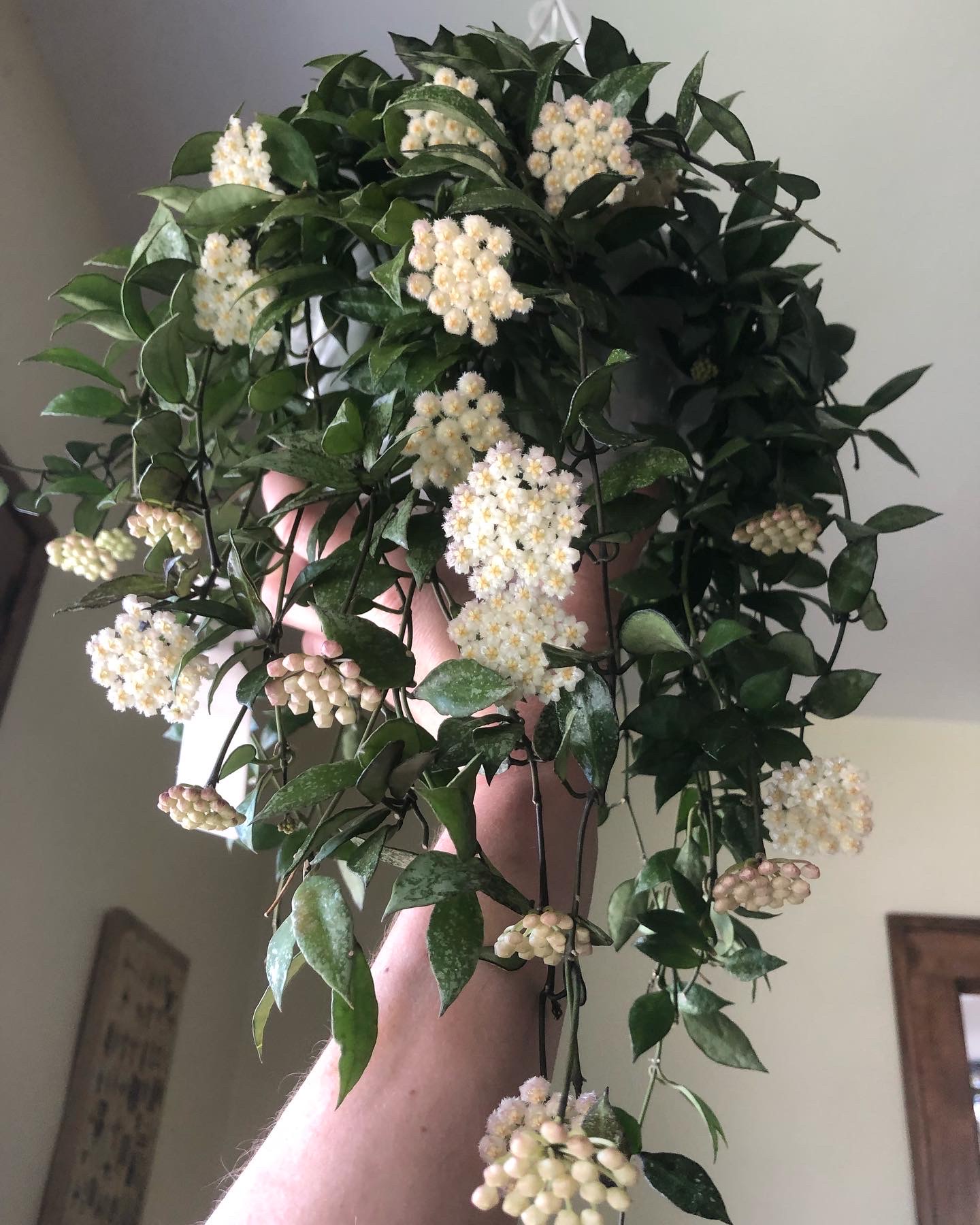
Full name
Hoya carnosa ‘Variegata’ is the accepted & established name for a unique cultivar (Articles 2.6, 21.5 Brickell et.al. 2016).
It was initially published as Hoya variegata. At the species rank, the name is a heterotypical synonym of Hoya carnosa (L.f.) R.Br.
Category
A clonal cultivar within the Hoya carnosa Variegated Group (V)
Synonyms
Hoya variegata Siebold ex C. Morr. ; Hoya variegata DeVriese; Hoya carnosa var. variegata (Siebold ex C.Morren) L.H. Bailey ; Hoya carnosa f. variegata (Siebold ex C.Morren) H.Hara
Introduction
in 1846, Hoya carnosa ‘Variegata’ was introduced to Europe from Japan by Philipp Franz von Siebold. It is unknown where the original discovery occurred.
Grower
Hoya carnosa ‘Variegata’ was selected for its marginal variegation and stated to have been propagated by two horticulturalists in Utrecht at Hortus Botanicus Leiden; a Mr. de Winter and a Mr. Jongeling. Mr.DeWinter was awarded a silver medal in 1845 at the botanical exhibition of the Ghent Society for Hoya carnosa ‘Variegata’. Mr. Joengeling & Mr. DeWinter purchased both of Siebold’s novelties Hoya carnosa ‘Picta’ and ‘Variegata’, for 7407 francs, and began to propagate them by cuttings “in a warm place under a smothered bell jar”.
Author
The director of the Hortus botanicus Leiden at the time was W.H.de Vriese. While Siebold appears to have engraved the nomenclatural type of ‘Variegata’ in the Annals, or his name is on it as an effect of honoring his introduction, even editor Charles Morren credits deVriese with the type description and states that the words are his, the editorial Morren’s own. All of these years the Hoya has been attributed in part to introducer Siebold as author, published effectively in full by Morren, but this does not appear to be entirely correct. It is of no import for the establishment of the cultivar, but should be stated that DeVriese first described ‘Variegata’, and Morren further contributed.
Publication
Hoya carnosa ‘Variegata’ was first fully described in 1846 in Annales de la Société Royale D’Agriculture et de Botanique de Gand, Tome II, P. 401-p.402, by each M.H.DeVriese and Charles Morren, accompanied by an engraving on page 400, presumably by Siebold (Editor Charles Morren), but artist uncertain.
(Translated from the Latin and French, both of which can be found in original form on pg. 401): “stems round, velvety-pubescent; petioles round, lineolate above, pubescent; leaves various, in the young age ovate-orbicular, tip short, pointed; later elliptic, lanceolate, acute at the base one edge prolonged, the other shorter, thickened, varied. (Flowers unknown).”
(Translated from French): “The Hoya variegata of Siebold is a new plant, introduced by the cares of the famous botanist and that we have seen figured at the exhibition at Ghent March 1845 where it earned the distinction of a special medal it so entranced the attention of the jury and the public. The plant was so beautiful and remarkable for its green variegated leaves washed, stained, and streaked broadside with white, and by its rose peduncles, that the committee appointed the Royale Society for the reception of the plants in the journal has decided it was not necessary to wait for the flowering of this species to publish its drawing. The coloration of the leaves was worthy of it without one flower, the horticultural value of the (species) is besides so high that the trade needs this representation and it is in its favor that the Annales publish it.” -Attributed to Charles Morren
Secondary valuable publications
In 1853, ‘Variegata’ bloomed in the greenhouse of Prince Frederick of the Netherlands, and W.H-DeVriese described the cultivar further.
(1853).Belg. Hort. III p.301-302:
“H.variegata, volubilis, radicans, ramulis teretibus velutino-subpubestibus, foliis, albo-variegatis, margine saepe roseis carnosis ovalibus ellipticis v. oblongis, subacuminatis, petiolis rubellis 2-3 centim. longis. pedunculus fusco-rubellis; corolla carnosa utrinque stellato barbulatis, coroae stamineae foliolos triangularibus, albis, in medio purpureis. Reliqua sunt ut in Hoya carnosa.
English translation: (As H.VARIEGATA, published in latin and french).
H.. Devr. Jaarb. v.d.kon. Nederl. maats. tot. aan,. v.d. tuinb. 1852,p.59,cum ic.
“Twining, rooting, branches rounded, velvety-subpubescent, leaves variegated with white, margin often pink, fleshy, ovate, elliptical, oblong, subacuminate, petioles reddish, 2-5cm long, peduncles reddish brown, corolla fleshy, pink on both sides, divisions subdeltoid, reflexed at the end and there are bearded-stellate, leaflets on the staminal crown. triangular, white, purple in the middle. The rest is as in H.carnosa.”
The text written by DeVriese was circulated widely.
Typification
There are three engravings included in the nomenclatural standards folder Hoya carnosa ‘Variegata’ which are all based on the original live material, published within a span of 9 years, and which are from published works. The 1846 engraving published by Charles Morren and credited to Siebold is the nomenclatural type. A print original is maintained in Harvard University Library of the Gray Herbarium.
Van Houtte & DeVriese’s 1853 Florre des Serres engravings and the April 1853 Belgique Horticole colored engravings each show the variable flush of color which creeps into some of the new growth of ‘Variegata’, and that it can bloom in this shade of pale purple (RHS-69-68). These engravings of the more mature cultivar as it came into bloom 7 years later are each considered to be useful additions for a more complete picture of the cultivar. They have been compared to live material. Print and pdf editions of the full volumes are held with the ICRA, along with the lithographs, and have been made available digitally thanks to the efforts of Harvard University Library and Biodiversity Heritage Library.
Here is the full Pdf edition of this registration available for download, with sources and images. Please contact the registrant/ICRA with corrections or prospective errors so that they may be amended. Questions are welcome, too:


